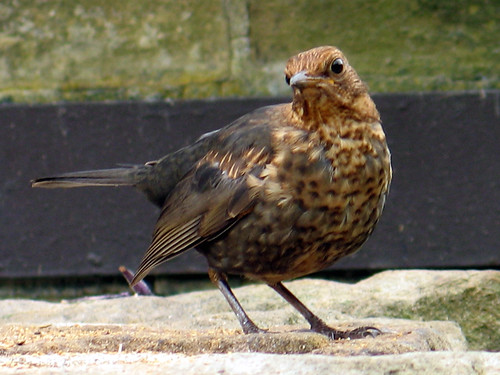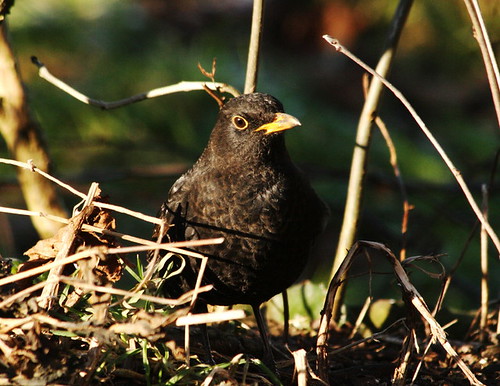The Common Blackbird Turdus merula is a species of true thrush.The male of the nominate subspecies, which is found throughout most of Europe, is all black except for a yellow eye-ring and bill and has a rich melodious song; the adult female and juvenile have mainly dark brown plumage. This species breeds in woods and gardens, building a neat, mud-lined, cup-shaped nest. It is omnivorous, eating a wide range of insects, earthworms, berries, and fruits.
Habitat
Common over most of its range in woodland, the Common Blackbird has a preference for deciduous trees with dense undergrowth. However, gardens provide the best breeding habitat with up to 7.3 pairs per hectare (nearly three pairs per acre), with woodland typically holding about a tenth of that density, and open and very built-up habitats even less
Male blackbirds establish a territory during their first year, which they will hold throughout their lives. The territory is essential for pair formation and nesting, although only a part of the food is obtained from within it
The breeding season lasts from early March to late July, and chicks are often found in a nest well into August. During this period, blackbirds rear 2-3 broods. In a good year, fourth broods may be attempted. Weather determines the timing of the breeding season.
The normal clutch size is 3-5. Larger clutches are laid in woodland than in gardens. The female incubates alone, and the chicks hatch 13-14 days later. Only the female broods the chicks, but both parents feed them. Chicks in gardens are fed on earthworms when they are available; woodland chicks are fed mainly on caterpillars.
The chicks are ready to fledge at 13-14 days, if the nest is disturbed, they can leave and survive as early as nine days old. This ability to fledge early is an important anti-predator adaptation. The young birds creep and flutter from the nest, and remain in nearby cover for the following few days.
Habitat
Common over most of its range in woodland, the Common Blackbird has a preference for deciduous trees with dense undergrowth. However, gardens provide the best breeding habitat with up to 7.3 pairs per hectare (nearly three pairs per acre), with woodland typically holding about a tenth of that density, and open and very built-up habitats even less
Male blackbirds establish a territory during their first year, which they will hold throughout their lives. The territory is essential for pair formation and nesting, although only a part of the food is obtained from within it
The breeding season lasts from early March to late July, and chicks are often found in a nest well into August. During this period, blackbirds rear 2-3 broods. In a good year, fourth broods may be attempted. Weather determines the timing of the breeding season.
The normal clutch size is 3-5. Larger clutches are laid in woodland than in gardens. The female incubates alone, and the chicks hatch 13-14 days later. Only the female broods the chicks, but both parents feed them. Chicks in gardens are fed on earthworms when they are available; woodland chicks are fed mainly on caterpillars.
The chicks are ready to fledge at 13-14 days, if the nest is disturbed, they can leave and survive as early as nine days old. This ability to fledge early is an important anti-predator adaptation. The young birds creep and flutter from the nest, and remain in nearby cover for the following few days.


No comments:
Post a Comment